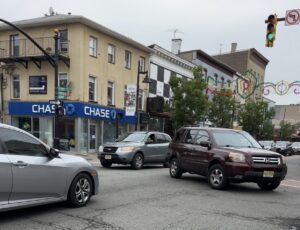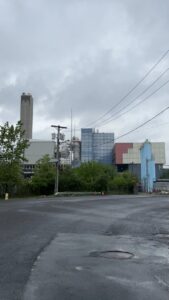
Car exhaust contributes to poor air quality on Ferry St. in Newark’s Ironbound neighborhood. (Photo by Spencer Brilhante)
This story was produced in collaboration with CivicStory as part of the NJ Ecology-Civics Reporting Project.
On a cloudy afternoon, John Goncalves pauses from sipping his coffee to monitor the long line of vehicles inching their way down Ferry Street. The stream of commercial trucks, buses, and SUVs is more than a constant irritant — it’s a health hazard that has begun to take a serious toll on those who live in the Ironbound.
Goncalves, who lives in this vibrant, working-class neighborhood in Newark’s East Ward, knows the issue with these pollutants far too well. He suffers from bronchitis.
“The air quality is the worst when there’s a game going on at the Prudential Center, and there’s a high volume of traffic,” Goncalves said, cup in hand, just outside Pao Da Terra Bakery. “I’ve been living in the Ironbound for a little over four decades, and it’s begun to take a serious toll on my health in recent years.”
The traffic is just one of the environmental and industrial factors contributing to the decades-old pollution issue in this diverse, densely packed community, jammed between the Passaic River, known as one of the most toxic waterways in the United States, and nearly every major interstate and highway in the region.
Just south of the Ironbound sits Newark Liberty International Airport, one of the nation’s busiest, and the neighborhood is bordered on the east by heavy manufacturing facilities, railroad tracks, and warehouses.
“We have one of the largest ports on the East Coast as well. That means that there are thousands of trucks that pass through the community on a daily basis. They might be idling in front of schools and homes, contributing further to the air pollution issues,” said JV Valladolid, a member of the nonprofit Ironbound Community Corporation’s Environmental Justice team.
One of the main culprits tainting the air is a garbage incinerator planted in the river’s bend at 183 Raymond Boulevard, not far from bustling Ferry Street. The facility is the state’s largest and one of the leading causes of air pollution, Valladolid said, adding that the plumes of smoke have led to a high number of cases related to cancer, asthma, and even premature death.
“It gets very hard to breathe,” said Isabella DaCosta, an 81-year-old Ironbound resident who has suffered from asthma since she was a young child. “Sometimes, I have no choice but to stay inside with the windows shut for the sake of my health.”
While ozone and fine particulate matter, particles less than 2.5 microns in diameter known as PM2.5, have generally been improving in New Jersey over the past several decades, it’s unknown what the threshold is for these pollutants to worsen health conditions including asthma, COPD, and heart disease, said Robert Laumbach, a professor at the Rutgers School of Public Health.
“Vulnerable people are not just those with pre-existing disease but also those with higher levels of exposure, such as living near sources of PM2.5, like busy roadways, or not having air conditioning and opening windows that let ozone enter the home in the summer,” Laumbach said.
A new fossil fuel-powered plant may be added to this neighborhood’s toxic legacy. The Passaic Valley Sewerage Commission is getting closer to gaining approval for the backup plant next to its current facility on Wilson Avenue.

A garbage incinerator in Newark converts waste into energy, while raising environmental concerns. (Photo by Spencer Brilhante)
The ICC opposes the facility, arguing that their neighborhood, home to many lower-income residents and immigrants from Portugal, Brazil, and Latin America, shouldn’t once again be forced to accept a facility that no other community wants.
Over the past five decades, the ICC and its Environmental Justice Team have tried tirelessly to get cleaner air and healthier living for residents by campaigning for clean air policies, hosting community-based events, and collaborating with other groups, Valladolid said.
Among its accomplishments, the organization and its partners advocated for what became New Jersey’s first environmental justice law in 2020. The regulation requires the state’s Department of Environmental Protection (NJDEP) to consider the public health impact of certain facilities on diverse, low-income neighborhoods known as overburdened communities.
Valladolid said they will continue to push for stronger environmental policies and cleaner air in hopes of improving the overall health of one of Newark’s most environmentally impacted communities.
Residents like DaCosta, who already suffer from health issues, welcome their efforts.
“I immigrated here from Portugal 50-something years ago, and I remember when the air felt more pure,” said DaCosta. “It’s scary to think what it’s doing to my health.”
This story was produced in collaboration with CivicStory as part of the NJ Ecology-Civics Reporting Project.
Co-published with The Observer.

Spencer Brilhante is a 2025 CivicStory Ecology-Civics fellow and a student journalist attending Rutgers University-Newark.
